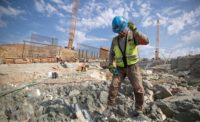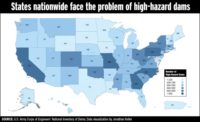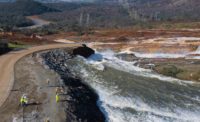A trio of failures at the 770-ft-tall earthfill Oroville Dam that prompted the evacuation of more than 188,000 people from central California has renewed questions about the reliability of hundreds of dams in the state and more nationally. It also has sent officials scrambling for the potential billions of dollars required to improve them.
In addition to discussion of dam safety, the failures and evacuation fed into the ongoing conversation in the U.S. over the condition of the American infrastructure.
A series of storms pounded northern California last month, opening up a 500-ft-long, 40-ft-deep crater on Oroville’s 3,050-ft-tall concrete-lined controlled spillway, dropping debris in the tailrace of the hydroelectric plant. The state Dept. of Water Resources shut down the spillway to evaluate the damage. At more than 100,000 cu ft per second (cfs), the continuing inflow to the 3.5-million acre-ft-capacity reservoir brought the water level at the tallest U.S. dam to its 901-ft capacity. That engaged the emergency spillway—a 1,700-ft-long unattached concrete weir, the first time in the dam's 50-year history.
On Feb. 11 and 12, between 6,000 to 12,600 cfs of water passed over that spillway, below the design volume but enough to send mud and trees into the Feather River, gouge holes in the hillside and cause erosion. The emergency evacuation was prompted by a fear that the cavities could undermine chunks of the levee, sending a 30-ft wall of water downstream.
“Sometimes, less water flowing generates more energy than higher flows,” said Bill Croyle, agency acting director.
Rock and Slurry
Restarting flows of up to 100,000 cfs on the damaged spillway and a declining storm brought reservoir levels down 50 ft, so crews could fill the pocked emergency spillway slope with 1,200 tons of rock and slurry. Later, as water crashed down the spillway at a relatively quiet 65,000 cfs, crews scrambled to dig out the hydroelectric plant’s spillway channel and reconnect cables so its 14,000-cfs drainage capacity could be reengaged.
Meanwhile, the debate continues about what went wrong, how it could have been avoided, how it should be fixed and who would pay for it. The American Society of Civil Engineers gave California a “D” for flood-control infrastructure in 2013, its last rating, with the next one set for release on March 9.
Mark Ogden, an ASCE member and technical specialist at the Association of State Dam Safety Officials, says more dams have been identified as deficient since the current report. The low grade stems from several factors, “including age—the average age is 56 years old—[and] better engineering standards … and development,” he says. With people living closer to dams, “more are now classified as high-hazard dams that need to be held to tougher standards.” While 78% of structures now are characterized as high hazard, the report noted improved emergency action plans. “We saw how important that was when Oroville had to put theirs in action,” Ogden says.
Ron Stork, senior policy advocate at Friends of the River, has worried for more than a decade about the reliability of the unlined emergency spillway. At Oroville’s relicensing in 2003, he and others testified that using “a hillside as the project spillway has potential to cause severe damage,” calling for armoring or reconstruction. But after a recent review of geologic conditions at the emergency spillway, state officials termed it “a safe and stable structure founded on solid bedrock that will not erode.”
Oroville Fixes
Stork cautions that, before repairs are conducted, the cause needs to be determined and any solution re-engineered based on current best practices and known hydrology. To just fix the three known spillway defects could cost a half-billion dollars, he estimates. The water-resources agency on Feb. 17 named five experts to a Federal Energy Regulatory Commission independent board to investigate the cause of the spillway failure and determine future risk, which could take three months.
Robert Bea, an engineering professor emeritus at the University of California, Berkeley, says any solution should comprise a new design that takes into account the actual hydrology, including a comprehensive inspection and maintenance plan. “Dams should be designed with the same factors of safety as a nuclear power plant,” he says. Bea says Oroville inspection reports “clearly show defects as a function of time.” The dam dates to 1968, the same vintage as many large dams in the state. “Patch and pray” is not a good risk strategy, he says. Bea points to three possible causes to consider: cavitation, shrinkage and unexpected water pressure on unstable soils.
J. Paul Tullis, a professor emeritus at Utah State University’s Water Research Laboratory, has long studied the devastating impacts of "cavitation"—small bubbles that can degrade surfaces by burrowing into cracks and creating cavities. The solution is to build aeration slots on the spillway face, he says. About 10 in. tall, channels across the spillway create a cushion. This solution was installed successfully on the Hoover and Glen Canyon dams in the 1980s. Hot, dry spells such as the ones during California’s four-year drought can open up fissures in cohesive soils, so that when the rains come, water has avenues to enter the sub-base.
“That can result in levee breaches as we saw with Hurricane Katrina in 2005,” Bea says. “It is obvious that the spillway suffered from water pressures directed from above and below,” he adds. Exposed igneous rock covered with eroded materials can fail when subjected to high-water effects, causing scarring and seepage.
New Spillway Suggested
Designing a new parallel spillway northwest of the current location would allow crews to work in the dry, while the current spillway is still actively moving water, says Henry W. Burke, a retired Kiewit civil engineer. Existing gates could be used and tied in using the existing headworks to minimize operational downtime. “A thicker, smooth chute would remove the irregularities that come from repairs, which can create shock waves that act like jackhammers, tearing up the concrete,” he says.
Building a new spillway from scratch also could improve energy dissipation where the discharge hits the Feather River, Burke contends. He calls for the immediate design of a main spillway replacement and award of a construction contract, estimated at $200 million, set for “the dry summer season on an expedited 24/7 basis.” Croyle says the state isn’t making any long-term decisions yet. “All options are on the table: temporary, permanent, repair, replace [or] build the spillway somewhere else? It is too early to tell,” he told reporters last month. “We have to get in and see what is under the water.”
Stork warns that Oroville’s vulnerabilities are not an anomaly. He points to two 50-year-old dams: Don Pedro Dam, a 585-ft-tall earthfill dam on the Tuolumne River, and New Exchequer, a 490-ft-tall earthfill dam on the Merced River; while not as tall, they are a part of critical-state flood-control infrastructure. Stork urges planners to look at the entire system—from adequate outlet works and levees to river and stream capacity—to avoid downstream flooding. “As the discharge system is upgraded, the downstream capacity will also have to be expanded through levee setbacks and improvements along the rivers the reservoirs feed into,” he says.
Of California’s 1,585 dams, the Association of Dam Safety Officials ranks 17 in poor condition and 97 in fair condition. Oroville Dam is one of 8,000 classified as major because of its size and importance to water supply. The group estimates that rehabilitating U.S. dams could cost more than $60 billion—$18.7 billion for non-federal, potentially high-hazard dams alone. On Feb. 12, President Donald Trump granted Gov. Jerry Brown’s request for a major disaster declaration, opening the door to federal funding. Trump said his goal was “a safe dam up there and all the other places where we have these kind of potential threats.” Even so, Croyle is still concerned about funding sources for upgrades beyond Oroville. “Congress passed legislation in December to fund dam infrastructure, and we need to plug into that for facilities all over California,” he says.






Post a comment to this article
Report Abusive Comment